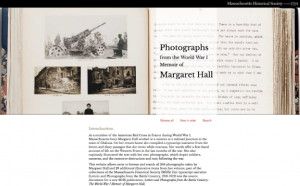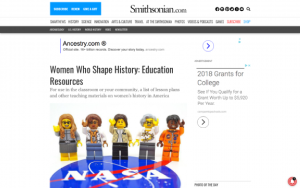General Interest
Back to Top
|
 |
|
Black Broadway on U: Where D.C.'s Cultural Renaissance was born
|
Arts |
|
In the early twentieth century, Washington, D.C.'s U Street neighborhood was home to a rich intellectual and artistic community. During the years, the historically Black neighborhood was home to numerous pivotal figures including anthropologist and writer Zora Neale Hurston, jazz musician Duke Ellington, and singer/actress Pearl Bailey (to name just a few) and hosted a number of Black-owned theaters and nightclubs. Launched in 2014 by Shellee M. Haynesworth, Black Broadway on the U is a "multi-platform story and public history initiative created to amplify, chronicle, preserve and enhance, the under-told story, cultural legacy, local memories and voices of Washington, D.C.'s marginalized Black community along the historic greater U Street community when it was known as 'Black Broadway,' a city within a city." This website is one component of that project. Here, visitors can explore a series of short documentary films that incorporate oral history interviews (in the stories section) and explore an interactive map that highlights over 60 important historic spots in the U-Street neighborhood (in the discover section). Fans of Black Broadway on the U may also want to follow this ongoing project on Twitter. [MMB] |
|





|
|
 |
|
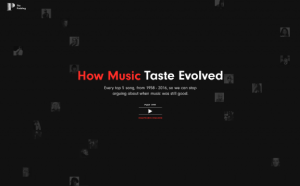 |
|
The Pudding: How Music Taste Evolved
|
Arts |
|
In August of 1958, the song "Nel Blu Dipinto Di Blu" by Italian musician and actor Domenico Modugno was the number one song on the U.S. Billboard Chart. Exactly ten years later, that honor went to the song "People Got to Be Free" by The Rascals. Exactly 50 years after that, in August 2008, Rihanna's "Disturbia" took the top Billboard slot. Visual journalist Matt Daniels of The Pudding, in collaboration with the Los Angeles-based design studio Use All Five, has created this highly enjoyable multimedia feature that allows visitors to explore all songs that entered the Billboard Top Five from August 1958 through October 2015. When visitors enter this website, they will initially be introduced to music from the year 1997. From here, visitors can change the year and month via a timeline that appears at the bottom of the screen. Once visitors select a start month and hit play, they will hear a clip of the song that was #1 at that time. Visitors will also see the four songs that accompanied that song in the Billboard's top five. As time passes, visitors will see new songs enter and leave the top five and hear a (sometimes disjointed) medley of songs that hit the #1 position over time. Users may also search for specific artists on a sidebar. This option reveals, for instance, that Diana Ross was in the top five a total of ten times in her career: first, in 1967 for The Supremes' "Reflections" and, most recently, in 1981 for "Endless Love." Collectively, this tool offers a fun way to rediscover songs and explore how popular music has evolved over time. [MMB] |
|





|
|
 |
|
Professor Buzzkill #127: Computer Dating
|
Social studies |
|
Computers play a central role in modern-day matchmaking, from dating apps to websites like OkCupid and Match.com. However, the history of computer dating is much older than many people realize. Professor Buzzkill is a podcast hosted by historian Joseph Cohill that features discussions about a wide variety of historical topics. On this recent episode of Professor Buzzkill (released, appropriately, on Valentine's Day 2018), technology historian Marie Hicks discusses the roots of computer dating. As Hicks explains, one of the earliest instances of computer matchmaking emerged in mid-twentieth century Great Britain. In 1961, a 27-year-old East Londoner named Joan Ball founded the Saint James Friendship Bureau, which was designed to help people find marriage partners. By 1964, Ball had renamed her organization the Saint James Computing Matching and was using technology to help individuals find compatible matches. To learn more about Ball's work and the fascinating history of computer dating, check out the full episode, available via the link above. [MMB] |
|





|
|
 |
|
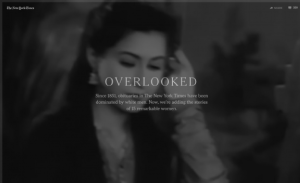 |
|
Overlooked
|
Social studies |
|
When Amisha Padnani became an obituary writer for The New York Times in 2017, she noticed that a number of important women throughout history had not received obituaries in the paper. Padnani decided to team up with Jessica Bennett, a gender editor at the Times to launch Overlooked: an initiative to provide obituaries for some of the women that Padnani couldn't locate in the paper's archives. On International Women's Day (March 8, 2018), the Times published this collection of fifteen obituaries of artists, activists, writers, athletes, and other important women that the Times overlooked in their obituary section throughout the years. In one obituary, Sewell Chan writes about the life of Marsha P. Johnson, a transgender activist who played a key role in the 1969 Stonewall uprising and, posthumously, was the subject of David France's 2017 film The Death and Life of Marsha P. Johnson. In another obituary, Aisha Khan writes about Bollywood star Madhubala, who appeared in dozens of films from the 1940s and 1950s before her premature death in 1969. Other women featured in this series include Ida B. Wells, Ada Lovelace, and Henrietta Lacks. The Times plans to add additional overdue obituaries each week, and readers are invited to nominate historical women to be featured in the series. [MMB] |
|





|
|
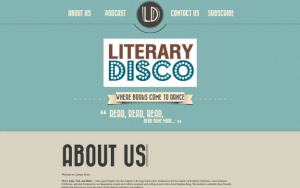 |
|
Literary Disco
|
Language Arts |
|
Literary Disco is a podcast hosted by book lovers Julia Pistell, Tod Goldberg, and Rider Strong. As the trio note on this website, "We're writers, but we've always been readers first and foremost." In keeping with this sentiment, Literary Disco is dedicated to discussing and reviewing books of all genres, including popular fiction, young adult literature, non-fiction, memories, genre fiction, and more. Pistell, Goldberg, and Strong launched this podcast in 2012, and continue to release new episodes once or twice a month. The three hosts often disagree with each other about books, leading to lively debates and discussions. Visitors can check out and listen to all current and past episodes of Literary Disco on this website. Recent episodes have explored Jennifer Egan's Manhattan Beach, George Saunders's Lincoln in the Bardo, and Elena Ferrante's My Brilliant Friend. [MMB] |
|





|
|
 |
|
Conscientious Photography Magazine
|
Arts |
|
Conscientious Photography Magazine is published and edited by Joerg Colberg and is the follow-up to his award-winning photography website Conscientious that went online in 2002. Photobooks are a major topic on Conscientious Photography Magazine: a recent post from March 5, 2018, discusses exhibition catalogs as a photobook genre. There are regular reviews of new photobooks, singly and in small groups, that are titled as reviews and dated by the week of the year in which they appeared. For example, W43/2017 reviews two books that utilize images selected from archives. Palladium contains archival photographs of Latvian Soviet-era movie theaters, edited by Andrejs Strokins and I loved my wife by Dieter de Lathauwer contains photographs from 16 Austrian psychiatric institutions that functioned as concentration camps for the mentally ill, where thousands of patients, many of them children, were executed during the Second World War. There are interviews and conversations with close to 150 individual photographers, dating back to 2002. The topical index also covers Colberg's writing on both Conscientious (2002-2013) and Conscientious Photography Magazine (2013 - ) and is intended to help readers compare older content with new. [DS] |
|





|
|

